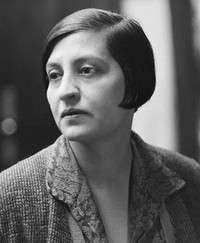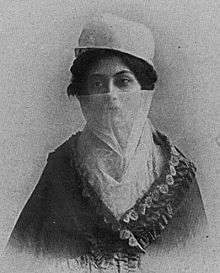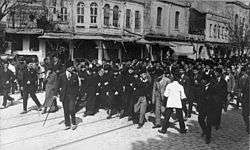Halide Edib Adıvar
Halide Edib Adıvar (Ottoman Turkish: خالده اديب [haːliˈde eˈdib]; sometimes spelled Halidé Edib in English) (11 June 1884 – 9 January 1964) was a Turkish novelist, nationalist, and political leader for women's rights. She was best known for her novels criticizing the low social status of Turkish women and what she saw as the lack of interest of most women in changing their situation.
Halide Edib Adıvar | |
|---|---|
 | |
| Member of the Grand National Assembly | |
| In office 14 May 1950 – 5 January 1954 | |
| Constituency | İzmir (1950) |
| Personal details | |
| Born | 11 June 1884 Constantinople (modern-day Istanbul), Ottoman Empire |
| Died | 9 January 1964 (aged 79) |
| Resting place | Merkezefendi Cemetery, Istanbul, Turkey |
| Citizenship | Turkey |
| Nationality | Turkish |
| Spouse(s) | Salih Zeki Adnan Adıvar |
| Education | American College for Girls |
| Occupation | Novelist |
| Awards | Şefkat Nişanı |
During World War I, Halide Edib ran an orphanage at the former Saint Joseph College in Antoura for Armenian orphans.[1][2][3]
She was a Pan-Turkist and several of her novels promoted Turanism.[4]
Early life
Halide Edib was born in Constantinople (Istanbul), Ottoman Empire to an upper-class family.[5] Her father was a secretary of the Ottoman Sultan Abdülhamid II.[4] Halide Edib was educated at home by private tutors from whom she learned European and Ottoman literature, religion, philosophy, sociology, piano playing, English, French, and Arabic. She learned Greek from her neighbors and from briefly attending a Greek school in Constantinople. She attended the American College for Girls[6] briefly in 1893. In 1897, she translated Mother by Jacob Abbott, for which the sultan awarded her the Order of Charity (Şefkat Nişanı).[7] She attended the American College again from 1899 to 1901, when she graduated. Her father's house was a center of intellectual activity in Constantinople and even as a child Halide Edib participated in the intellectual life of the city.[8]
After graduating, she married the mathematician and astronomer Salih Zeki Bey, with whom she had two sons. She continued her intellectual activities, however, and in 1908 began writing articles on education and on the status of women for Tevfik Fikret's newspaper Tanin and the women's journal Demet. She published her first novel, Seviye Talip, in 1909. Because of her articles on education, the education ministry hired her to reform girls' schools in Constantinople. She worked with Nakiye Hanım on curriculum and pedagogy changes and also taught pedagogy, ethics, and history in various schools. She resigned over a disagreement with the ministry concerning mosque schools.[9]
She received a divorce from Salih Zeki in 1910. Her house became an intellectual salon, especially for those interested in new concepts of Turkishness. She became involved with the Turkish Hearths (Türk Ocağı) in 1911 and became the first female member in 1912. She was also a founder of the Elevation of Women (Taali-i Nisvan) organization.[10]
She became a friend of Armenian priest, musician and later Armenian Genocide victim Komitas between 1913 and 1914. Komitas had been invited to sing at her house several times. While Halide Edib was friendly towards him in person, in her writings she described Komitas and his music as "Anatolian" instead of Armenian. She claimed that his music had been stolen from Turks and that he "simply turned the words into Armenian".[11] In addition, she believed that his parents were "probably of Turkish descent" and that "he was an Armenian nationalist whether his origin was Turkish or Armenian, but in temperament and heart he was a real Anatolian Turk if unconsciously."[12]
During World War I and the Armenian Genocide

She married again in 1917 to Dr. Adnan (later Adıvar) and the next year took a job as a lecturer in literature at Istanbul University's Faculty of Letters . It was during this time that she became increasingly active in Turkey's nationalist movement, influenced by the ideas of Ziya Gökalp.
In 1916–1917, she acted as Ottoman inspector for schools in Damascus, Beirut and the Collège Saint Joseph in Mount Lebanon. The students at these schools included hundreds of Armenian, Arab, Kurdish, and Turkish orphans.[13] In the course of the Armenian Genocide and under the direction of Halide Edib Adıvar and Djemal Pasha, one of the Three Pashas who organized the Armenian Genocide, about 1,000 Armenian and 200 Kurdish children were Turkified at the Collège Saint Joseph in Aintoura.[1][2]
Halide Edip's account of her inspectorship emphasizes her humanitarian efforts and her struggles to come to terms with the violence of the situation. However an American witness for The New York Times, describing her as "this little woman who so often boasts of her American ideals of womanhood and of which her Western friends make so much", accused Halide Edip of "calmly planning with [Cemal Pasha] forms of human tortures for Armenian mothers and young women" and taking on "the task of making Turks of their orphaned children."[14] Robert Fisk wrote that Halide Edip "helped to run this orphanage of terror in which Armenian children were systematically deprived of their Armenian identity and given new Turkish names, forced to become Muslims and beaten savagely if they were heard to speak Armenian".[3]
Karnig Panian, author of Goodbye, Antoura, was a six-year-old Armenian Genocide survivor at the orphanage in 1916. Panian's name was changed to the number 551. He witnessed children that resisted Turkification being punished with beatings and starvation:[3]
At every sunset in the presence of over 1,000 orphans, when the Turkish flag was lowered, 'Long Live General Pasha!' was recited. That was the first part of the ceremony. Then it was time for punishment for the wrongdoers of the day. They beat us with the falakha [a rod used to beat the soles of the feet], and the top-rank punishment was for speaking Armenian.
Emile Joppin, the head priest at the Saint Joseph College in Antoura, wrote in a 1947 school magazine:[3]
The Armenian orphans were Islamicised, circumcised and given new Arab or Turkish names. Their new names always kept the initials of the names in which they were baptised. Thus Haroutioun Nadjarian was given the name Hamed Nazih, Boghos Merdanian became Bekir Mohamed, to Sarkis Safarian was given the name Safouad Sulieman.
In a 1918 report, American Red Cross officer Major Stephen Trowbridge, met with surviving orphans and reported:[3]
Every vestige, and as far as possible every memory, of the children's Armenian or Kurdish origin was to be done away with. Turkish names were assigned and the children were compelled to undergo the rites prescribed by Islamic law and tradition ... Not a word of Armenian or Kurdish was allowed. The teachers and overseers were carefully trained to impress Turkish ideas and customs upon the lives of the children and to catechize [sic] them regularly on ... the prestige of the Turkish race.
Professor of Human Rights Studies Keith David Watenpaugh compared the treatment of non-Turkish orphans by Halide Edip and Djemal Pasha to the American and Canadian schools for Native American children that were forcibly assimilated and often abused.[15] He wrote that Edip showed a strong hatred of Armenians in her writings, portraying them as "a mythical and existential enemy of the Ottomans" and even made claims of blood libel and child cannibalism similar to those in anti-Semitism. She also claimed a conspiracy to turn Turkish children into Armenians, "thus also turning the accusations leveled against her for her work at Antoura back toward the Armenians themselves".[16] Watenpaugh writes of her:[17]
Modernizing Turkey and defending its Muslim elite against Western criticism are key elements of Halide Edip's life's work, but her reluctance to protect Armenian children or even voice empathy for them as victims of genocide shows a basic lack of human compassion. For Halide Edip questions of social distinction and religion placed limits upon the asserted universal nature of humanity; for her, genocide had not been too high a price to pay for Turkish progress, modernity, and nationalism.
Despite her role in the orphanages in Antoura, Halide Edib expressed her sympathies with the Armenians regarding the bloodshed and drew the rage of the Committee of Union and Progress members inciting them to call for her punishment.[18] Talat Pasha refused to administer any and said that "She serves her country in the way she believes. Let her speak her mind; she is sincere."[18][18] A U.S. High Commissioner refers to her as a "chauvinist" and someone who is "trying to rehabilitate Turkey."[19] On the other hand, German historian Hilmar Kaiser says: "And even if you're a Turkish nationalist, that doesn't make you a killer. There were people who were famous Turkish nationalists like Halide Edip; she advocated assimilation of Armenians, but she very strongly opposed any kind of murder."[20]
On 21 October 1918, Halide Edip then wrote an article in the Vakit newspaper condemning the massacres: "We slaughtered the innocent Armenian population ... We tried to extinguish the Armenians through methods that belong to the medieval times".[21][22][23]
During the War of Independence

After the defeat of the Ottoman Empire in World War I, British troops occupied Constantinople and allies occupied various parts of the empire. Mustafa Kemal (later Atatürk) began organizing resistance to the occupation. Halide Edib gained a reputation in Istanbul as a "firebrand and a dangerous agitator."[24] She was one of the main figures of Empire to give speech to thousands of people protesting the Occupation of Izmir by Greece during the Sultanahmet demonstrations. The British tried to exile her and several other leaders to Malta in March 1920.
Halide Edib escaped to Anatolia together with her husband to join the Turkish National Resistance. On the road to Ankara she met with Yunus Nadi, another journalist who had decided to join the Nationalists. In a meeting at the train station in Geyve, on 31 March 1920, they agreed on the importance of informing the international public opinion about the developments regarding the Turkish War of Liberation and decided to help the national struggle by establishing a news agency. They concurred on the name "Anadolu Ajansı".[25][26]
During the Greco-Turkish War (1919-1922) she was granted the ranks of first corporal and then sergeant in the nationalist army. She traveled to the fronts, worked in the headquarters of İsmet Pasha, Commander of the Western Front and wrote her impressions of the scorched earth policy of the invading Greek army and the Greek atrocities in Western Anatolia in her book "The Turkish Ordeal".
After the War

In 1926, Halide Edib and many associates were accused of treason. She and her husband escaped to Europe.[27] They lived in France and the United Kingdom from 1926 to 1939. Halide Edib traveled widely, teaching and lecturing repeatedly in the United States and in India. She collected her impressions of India as a British colony in her book "Inside India".[28] She returned to Turkey in 1939, becoming a professor in English literature at the Faculty of Letters in Istanbul. In 1950, she was elected to Parliament, resigning in 1954; this was the only formal political position she ever held.
Literature
Common themes in Halide Edib's novels were strong, independent female characters who succeeded in reaching their goals against strong opposition. She was also a fervent Turkish nationalist, and several stories highlight the role of women in Turkish independence.
She was a Pan-Turkist and promoted Turanism in several of her novels. Her book Yeni Turan calls for the unification of Turkic peoples in Central Asia and the Caucasus under an empire led by Turkey.[4]
Description
A contemporary described her as "a slight, tiny little person, with masses of auburn hair and large, expressive Oriental eyes, she has opinions on most subjects, and discusses the problems of the day in a manner which charms one not so much on account of what she says, but because it is so different from what one expected".[29]
Death
Halide Edib died on January 9, 1964 in Istanbul. She was laid to rest at the Merkezefendi Cemetery in Istanbul.[30]
Major works
- Seviye Talip (1910).
- Handan (1912).
- Mevut Hükümler (1918).
- Yeni Turan (1912).
- Son Eseri (1919).
- Ateşten Gömlek (1922; translated into English as The Daughter of Smyrna or The Shirt of Flame).
- Çıkan Kuri (1922).
- Kalb Ağrısı (1924).
- Vurun Kahpeye (1926).
- The Memoirs of Halide Edib, New York-London: The Century, 1926 (published in English). Profile
- The Turkish Ordeal, New York-London: The Century, 1928 (memoir, published in English).
- Zeyno'nun Oğlu (1928).
- Turkey Faces West, New Haven-London: Yale University Press/Oxford University Press, 1930.
- The Clown and His Daughter (first published in English in 1935 and in Turkish as Sinekli Bakkal in 1936).
- Inside India (first published in English in 1937 and in Turkish as Hindistan'a Dairin its entirety in 2014.)
- Türk'ün Ateşle İmtihanı (memoir, published in 1962; translated into English as House with Wisteria).
As a character in literature and film
- The novel Halide's Gift by Frances Kazan (2001) is a coming-of-age story about Halide Edib's youth and maturation.
- Halide Edib appears as a character in several films and television shows including Kurtuluş,[31] Cumhuriyet,[32] and The Young Indiana Jones Chronicles.[33]
- Several of Halide Edib's novels have also been adapted for film and television.[34]
- Halide Edib is the subject of The Greedy Heart of Halide Edib, a documentary film for school children.[35]
See also
Footnotes
- Fisher, page 164.
- Kévorkian, page 843.
- Fisk, Robert "Living Proof of the Armenian Genocide" (9 March 2010) The Independent
- Meyer, pages 161-162
- Britannica, Istanbul:When the Republic of Turkey was founded in 1923, the capital was moved to Ankara, and Constantinople was officially renamed Istanbul in 1930.
- Üsküdar American Academy.
- "Ottoman medal for 'compassionate' British lady to go under the hammer". Hurriyet Daily News. 24 January 2015.
- Erol, pages vii–viii.
- Erol, page viii.
- Erol, page ix.
- Adıvar, pages 421.
- Adıvar, pages 422.
- Adıvar, pages 431–471.
- New York Times, page 97. (1922, September 17) "The Turkish Jeanne d'Arc: An Armenian Picture of Remarkable Halide Edib Hanoum"
- Panian, page xii.
- Panian, page xvi.
- Panian, page xvii.
- Adıvar, pages 388.
- Mark Lambert Bristol, undated confidential report, cited in Hovannisian, page 122; page 141, note 29.
- "Historian challenges politically motivated 1915 arguments" Archived 2 December 2013 at the Wayback Machine, Today's Zaman, 22 March 2009.
- Dadrian, Vahakn N.; Akçam, Taner (2011). Judgment at Istanbul the Armenian genocide trials (English-language ed.). New York: Berghahn Books. p. 28. ISBN 085745286X.
- Insel, Ahmet. ""This Conduct Was a Crime Against Humanity": An Evaluation of the Initiative to Apologize to the Armenians". Birikim.
- "Eye Witnesses Tell The Story". Greek America. Cosmos Communications Group. 4 (1–7): 36. 1998.
- "Turk Nationalists."
- Anadolu Ajansı. Kuruluşundan Bugüne Anadolu Ajansı Archived 2013-01-15 at the Wayback Machine
- CERTAIN DOCUMENTS CONCERNING THE ESTABLISHMENT OF THE ANATOLIAN NEWS AGENCY AND ITS WORK DURING THE WAR OF NATIONAL INDEPENDENCE (1920) Archived 2013-04-18 at Archive.today
- Marcosson, pages 174–175.
- Halide Edip Adıvar’ın Hindistan’daki Konferansları Archived 2013-11-27 at the Wayback Machine
- Ellison, Grace Mary. An English woman in a Turkish harem. (1915) London : Methuen & Co., Ltd.
- "Halide Edip Adıvar" (in Turkish). Yazar Mezar. Archived from the original on 14 September 2011. Retrieved 14 October 2011.
- Internet Movie Database. Retrieved 4 September 2009 Kurtulus.
- Internet Movie Database. Cumhuriyet. Retrieved 4 September 2009.
- Internet Movie Database. The Young Indiana Jones Chronicles. Retrieved 4 September 2009.
- Internet Movie Database. Halide Edip Adivar. Retrieved 4 September 2009.
- Indy in the Classroom: Documentaries: Masks of Evil Archived 2011-05-28 at the Wayback Machine. Retrieved 5 September 2009.
References
- Adıvar, Halide Edip. (1926) Memoirs of Halidé Edib. John Murray.
- Adler, Philip J., & Randall L. Pouwels. (2007) World Civilizations: To 1700. Cengage Learning. ISBN 978-0-495-50261-6.
- Davis, Fanny. (1986) The Ottoman Lady: A Social History from 1718 to 1918.
- Erol, Sibel. (2009) Introduction to House with Wisteria: Memoirs of Turkey Old and New by Halide Edip Adıvar. Transaction Publishers. ISBN 978-1-4128-1002-9.
- Fisher, Harriet Julia. (1917) "Adana. Inquiry Document 813." In James L. Barton, Turkish Atrocities: Statements of American Missionaries on the Destruction of Christian Communities in Ottoman Turkey, 1915–1917. Gomidas Institute, Ann Arbor. 1998. ISBN 1-884630-04-9.
- Heck, J. G. (1852) Iconographic Encyclopaedia of Science, Literature, and Art. Trans. Spencer F. Baird.
- Hovannisian, Richard G. (1999) Remembrance and Denial: The Case of the Armenian Genocide. Wayne State University Press. ISBN 978-0-8143-2777-7.
- Kévorkian, Raymond. (2006) Le Génocide des Arméniens. Odile Jacob, Paris. ISBN 2-7381-1830-5.
- Larousse.fr. (No date) "Istanbul." Retrieved 3 June 2010.
- Marcosson, Isaac Frederick. (1938) Turbulent Years. Ayer Publishing.
- Meyer, James. (2014) Turks Across Empires: Marketing Muslim Identity in the Russian-Ottoman Borderlands, 1856-1914. Oxford University Press.
- Mitler, Louis. (1997) Contemporary Turkish Writers.
- Sonmez, Emel. (1973) "The Novelist Halide Edib Adivar and Turkish Feminism." Die Welt des Islams, New Ser. Vol. 14, Issue 1/4: 81–115.
- Stathakopoulos, Dionysios. (2008, November) "The Elusive Eastern Empire." History Today, Vol. 58, No. 11.
- "Turk Nationalists Organize to Resist." (1920, March 20) New York Times, page 5.
- Üsküdar American Academy. About Halide Edip Adıvar. Retrieved 20 September 2009.
- Vauchez, André, Richard Barrie Dobson, & Michael Lapidge. (2000) Encyclopedia of the Middle Ages. Routledge. ISBN 978-1-57958-282-1.
- Yeghenian, Aghavnie. (1922, September 17) "The Turkish Jeanne d'Arc: An Armenian Picture of Remarkable Halide Edib Hanoum" (letter to editor). New York Times, page 97.
- Fisk, Robert "Living Proof of the Armenian Genocide" (9 March 2010) The Independent
External links
| Wikimedia Commons has media related to Halide Edib Adıvar. |
- Notable Ladies: Halide Edib Adivar
- Halide's Ordeal
- Halide Edip Adivar by Turkish Cultural Foundation.